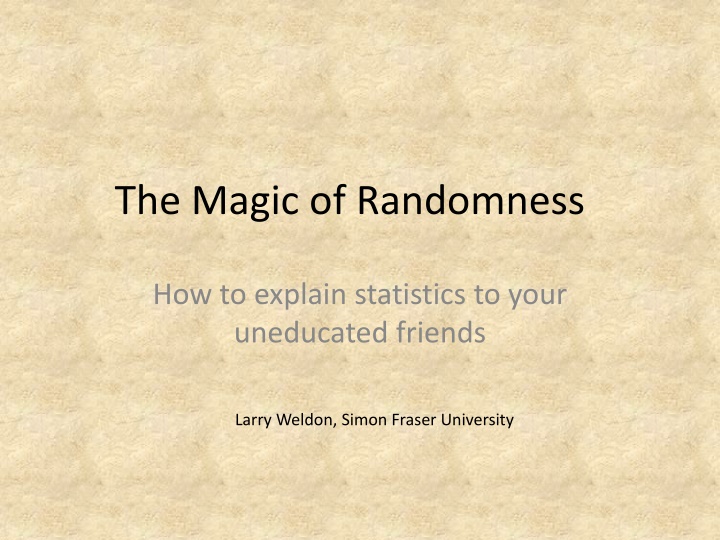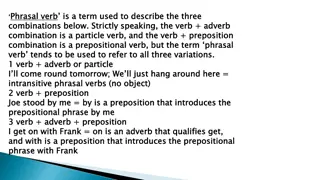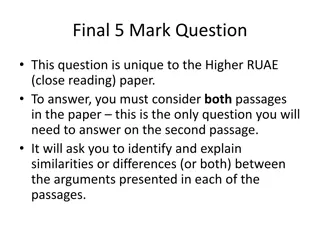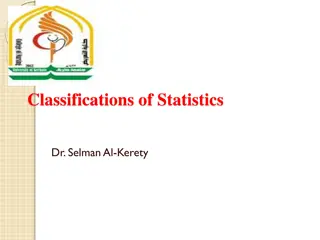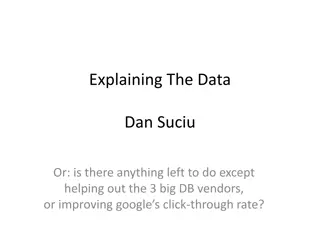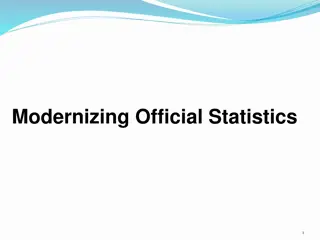Explaining Statistics to Friends
Dive into the world of statistics with engaging topics such as significance, standard deviation, and real-world applications like sports and stock prices. Learn how randomness plays a crucial role in research, sports outcomes, and even stock market predictions. Discover the impact of luck in assessing sports results and explore the intriguing concept of symmetric random walks in stock prices. Unearth the language of statistics in a relatable manner that makes complex concepts understandable for all.
Download Presentation

Please find below an Image/Link to download the presentation.
The content on the website is provided AS IS for your information and personal use only. It may not be sold, licensed, or shared on other websites without obtaining consent from the author.If you encounter any issues during the download, it is possible that the publisher has removed the file from their server.
You are allowed to download the files provided on this website for personal or commercial use, subject to the condition that they are used lawfully. All files are the property of their respective owners.
The content on the website is provided AS IS for your information and personal use only. It may not be sold, licensed, or shared on other websites without obtaining consent from the author.
E N D
Presentation Transcript
The Magic of Randomness How to explain statistics to your uneducated friends Larry Weldon, Simon Fraser University
Language of Statistics? Significance Normal Standard Deviation Mean Expected Value Error Greek Symbols! Suggests a discipline that is out-of-touch with Reality!
The Skeptical Public Skeptical Public Show me the benefit Stat Inference in Research (Drug Trials, Survey Summaries) Will ignorance cost me? I don t do research. Is it always so complicated? I m too busy to re-train Is it de-humanizing? I m a people person
Applications from the Real World Sports Investment Fuel Consumption Lotteries Peer Review Traffic
Sports from the internet NBA Pacific Division of Western Conference 2010 data Pacific W L PCT GB CONF DIV HOME ROAD L 10 STREAK L.A. Lakers 38 17 0.691 0.0 21-11 8-3 19-8 19-9 6-4 L 1 Phoenix 26 26 0.500 10.5 15-16 6-5 15-12 11-14 6-4 L 1 L.A. Clippers 20 34 0.370 17.5 13-21 7-4 16-14 4-20 3-7 L 2 Golden State 24 29 0.453 13.0 14-20 4-8 18-11 6-18 5-5 W 1 Sacramento 13 38 0.255 23.0 8-23 3-8 7-22 6-16 4-6 W 1 pacific.nba=c(.73, .64, .55, .33, .27) Proportions of games Won (in approx 11 games) Are the LA Lakers demonstrably better than Sacramento? (There had to be top team even if no quality difference.)
NBA example - continued What would happen in this division if every team had a 50% chance of winning every game? Would the win rate vary as much? Let s simulate what would happen go to R: lg.win.index(northwest.nba,m=11) lg.win.index(pacific.nba,m=11)
Sports Leagues Demo: So what? We argued that the effects of randomness (or luck) in sports is under-appreciated. Simulation enables us to allow for luck in assessing sports outcomes The smart money would back the underdog, with good odds (at least in Pacific Division).
Stock Prices and Random Walks Symmetric Random Walks produce patterns that suggest predictability go to R: simple.walk() shows accumulation heads rwalk.run(avg=F) shows illusionary trends But the stock market varies like a random walk fund.walk() realistic fund price generator fund.walk.test() shows parameter control fund.walk.run() use of past performance?
Random Walks & Funds: So what? Fund price trends display apparent patterns that are not real trends (not predictive) Past fund price trends are very poor predictors of future prices, even when mgr quality varies. Knowing how much apparent trend is due to chance allows real trends to be identified.
Diversification of Investments Portfolio with Independent Components Components need not be stable Consider Risky Company Risky Company 1 Year Outcome Probability $0.00 0.25 $0.50 0.25 $1.00 0.25 $4.00 0.25 1 Yr NET Outcome Probability -$1.00 0.25 -$0.50 0.25 $0.00 0.25 $3.00 0.25 [1] -1.0 -0.5 0.0 -1.0 -1.0 -0.5 [7] -1.0 0.0 3.0 3.0 0.0 0.0 [13] 0.0 -1.0 -1.0 -0.5 3.0 3.0 [19] -0.5 3.0 -0.5 -0.5 -1.0 3.0 [25] 3.0
Simulations for Risky Portfolio Go to R risky.sample(prt.tables=F) experience for 1 co. risky() showing experience for 25 companies.
Risky Company Portfolio: So What? A variable return is not necessarily a risky return. Variability is NOT risk. SD does not measure risk. Risk is the chance of loss. If a portfolio has companies which are profitable on average, and if the success of the companies have a measure of independence, then the portfolio will very likely be profitable.
Gasoline Consumption Example Uncovering hidden information through modern graphics 2/25/2025 STAT 100 13
Gasoline Consumption Each Fill - record kms and litres of fuel used Smooth ---> Seasonal Pattern Jan 12, 2010 STAT 100 14
Smoothing amplifies signal but introduces bias by cutting off peaks and valleys Jan 12, 2010 STAT 100 15
Illustration of Effect Artificial Data Jan 12, 2010 STAT 100 16
Intro to smoothing with context Jan 12, 2010 STAT 100 17
Gas Consumption Example: So What? 1. Smoothing can reveal info not otherwise observable. 2. Use of the technique combines the technique of averaging with real-world common sense. 3. Subjectivity is a necessary part of good data analysis. Jan 12, 2010 STAT 100 18
Public Lotteries (like 6/49) Cash flow Ticket proceeds in (100%) Prize money out (50%) Good causes (35%) Administration and Sales (15%) $1.00 ticket worth 50 cents, on average Typical lottery P(jackpot) = .0000007 2/25/2025 LS 829 - 2010 19
How small is .0000007? Buy 10 tickets every week for 60 years Cost is $31,200. Chance of winning jackpot is = . 1/5 of 1 percent! 2/25/2025 LS 829 - 2010 20
Lottery Example So What? 1. Lottery is not a good investment from financial perspective. 2. Long participation is no guarantee of a big win. 3. Almost always, long participation results in a big loss.
Peer Review Motivating Example Motherhood Procedure? SFUs Diverse Qualifications Admissions 2 referees, each assign 0,1,2,3 to case rank applicants and accept best ones problem: referees vary drastically in toughness Admission depended on referee assignment Luck! Corrected Problem by forcing calibration of refs 2/25/2025 STAT 100 22
Peer Review More General Submissions to publishers (popular press or academic journals) How sensitive to referee choice? Assume 2 refs. If agree yes -> publish 95% If agree no -> reject 100% If disagree -> publish 20% Consider processing of 100 submissions 2/25/2025 STAT 100 23
Simulation of Peer Review Process Assume refs approve 0-50% (avg 20%) Assume quality varies over 0-1 (avg 0.5) Modulate ref approval pct by quality (Paper quality must influence approval - this is built in to the model more later). Go to R: peer()
Combining Quality & Ref. Toughness an example: Ref averages 25% approval, say Particular paper has quality 0.8, say Refs % approval for this paper is 25% + (0.8-0.5)/0.5 * (100%-25%) = 70% peer() again ask why good papers are not often published
Peer Review: So What? Procedures that appear fair can become very unfair because of randomness Any system in which a small number of assessors are selected from a larger group of assessors can be flawed for this reason. (e.g. university grades!) 2/25/2025 STAT 100 26
Traffic Q: What causes the accordion effect in heavy, one-lane, automobile traffic? Go to R: traff.run()
Traffic So What? Complex Behavior can sometimes have a simple explanation once randomness is accounted for.
Overall Take-away Message? An education in statistics allows one to understand many aspects of daily life, not merely the arcane detail of data-based research, and we should share this awareness widely.
The End Thank you for listening Questions? Comments? These slides are posted at www.stat.sfu.ca/~weldon R programs available: email weldon@sfu.ca 2/25/2025 STAT 100 30
Sports Again: Hockey Can we tell from a game which team is the better team? Define team quality as Prob y(get next goal) How often does A win if quality A = 0.6? (As of Feb 22, Canucks were 38/61 = 0.62 for games. What does this imply for quality?) go to R: hockey(ngames=100,ateam=.6) hockey.game(ateam=.6)
Zipfs Law plotzipf(CANcitypops,CANcitynames) plotzipf(UScitypops,UScitynames)
